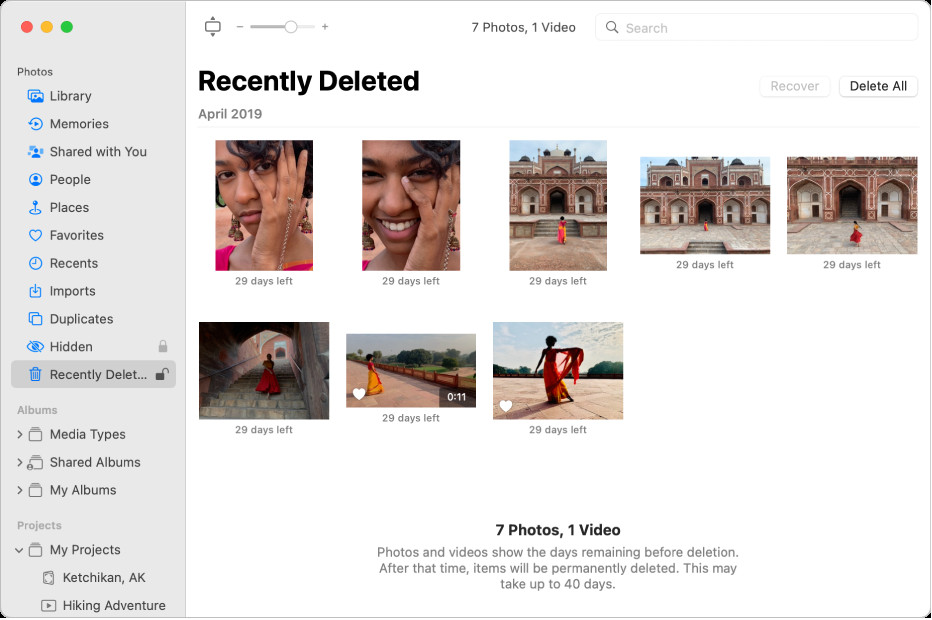Accidentally deleting precious photos from your iPhone can be a heart-stopping moment. Those images often hold irreplaceable memories, and the thought of losing them forever can be distressing. If you’re asking “Is There Anyway To Recover Deleted Photos On Iphone?”, you’ll be relieved to know that in most cases, the answer is a resounding yes! Apple has built-in mechanisms to help you get your deleted photos back, and this guide will walk you through each method step-by-step.
Understanding the “Recently Deleted” Album: Your First Line of Defense
When you delete a photo or video on your iPhone, it doesn’t immediately vanish into thin air. Instead, it’s moved to a special album called “Recently Deleted”. Think of this as your iPhone’s recycle bin for photos. This album gives you a 30-day grace period to recover anything you might have deleted by mistake. After 30 days, the items are permanently removed.
This feature is incredibly useful for quickly undoing accidental deletions. It’s the first place you should check when you realize a photo is missing.
How to Recover Deleted Photos Directly on Your iPhone
The most straightforward way to recover deleted photos is directly through your iPhone’s Photos app. Here’s how:
-
Open the Photos App: Locate and tap the Photos app icon on your iPhone’s home screen.
-
Navigate to the Albums Tab: At the bottom of the screen, you’ll see several tabs. Tap on “Albums”.
-
Find the “Recently Deleted” Album: Scroll down to the “Utilities” section. Here, you will find the “Recently Deleted” album.
-
Unlock if Necessary: If you are using iOS 16, iPadOS 16.1, or later, the Recently Deleted album might be locked for extra security. Use Face ID or Touch ID to unlock it.
-
Select Photos to Recover: Once inside the “Recently Deleted” album, tap “Select” in the top right corner. Then, tap on each photo or video you want to recover. If you want to restore everything, you can usually find a “Recover All” option.
-
Recover Your Photos: After selecting the desired photos, tap the “Recover” button at the bottom right. Confirm your action by tapping “Recover Photo” (or similar wording) when prompted.
 Recover deleted photos from Recently Deleted album on iPhone
Recover deleted photos from Recently Deleted album on iPhone
Once recovered, your photos and videos will be restored to their original locations within your main Photos Library, appearing in your albums and chronological order.
Recovering Deleted Photos from iCloud.com
If you use iCloud Photos to sync your photos across devices, you can also recover deleted photos through the iCloud website. This is particularly helpful if you’re not near your iPhone but have access to a computer.
-
Go to iCloud.com and Sign In: Open a web browser and go to iCloud.com. Log in using your Apple ID and password.
-
Open the Photos App on iCloud: Once logged in, click on the “Photos” icon.
-
Access the “Recently Deleted” Album: In the Photos app on iCloud.com, look for the sidebar. If you don’t see it, there’s usually a sidebar icon (often three horizontal lines or a similar symbol) to click to reveal it. In the sidebar, click on “Recently Deleted”.
-
Select and Recover Photos: Select the photos or videos you wish to recover. You can select multiple items by holding down the Command key (on Mac) or Control key (on Windows) while clicking. Once selected, click the “Recover” button.
 Recover deleted photos from Recently Deleted album on iPhone
Recover deleted photos from Recently Deleted album on iPhone
Just like on your iPhone, recovered photos will be returned to your iCloud Photos library and will sync back to all your devices connected to iCloud Photos.
Restoring Photos on Mac from the “Recently Deleted” Album
If you primarily manage your photos on a Mac and use iCloud Photos, you can also recover deleted photos from the “Recently Deleted” album on your Mac’s Photos app.
-
Open the Photos App on Mac: Launch the Photos application on your Mac.
-
Find “Recently Deleted” in the Sidebar: In the Photos app, you’ll see a sidebar on the left. Click on “Recently Deleted”. You might need to use Touch ID or your password to unlock this album if you have that security feature enabled.
-
Select and Recover Photos: Choose the photos you want to restore. Click “Recover” to move them back to your main Photos library.
 Recover deleted photos from Recently Deleted album on iPhone
Recover deleted photos from Recently Deleted album on iPhone
What if Photos are Permanently Deleted?
If the 30-day window has passed, or you’ve emptied the “Recently Deleted” album, recovering photos becomes more challenging but not entirely impossible.
-
Check iCloud Backup: If you back up your iPhone to iCloud, you might be able to restore your entire backup to a point before the photos were deleted. However, this will revert your iPhone to that backup state, potentially losing any data added since that backup.
-
Time Machine Backup (Mac): If you use Time Machine to back up your Mac, and your Photos library was stored on your Mac and backed up, you might be able to restore your Photos Library from a Time Machine backup.
-
Third-Party Recovery Software: For photos permanently deleted and not backed up, specialized data recovery software might be able to scan your device’s storage for recoverable files. However, success is not guaranteed, and it’s best to use reputable software.
Act Fast to Recover Your Deleted Photos
The key takeaway is that recovering deleted photos on your iPhone is usually possible, especially if you act quickly. The “Recently Deleted” album is a lifesaver for accidental deletions. Regularly backing up your iPhone and understanding these recovery methods can save you from the heartache of losing your precious photo memories.
Further Resources:
